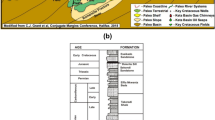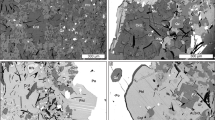Summary
Natural occurring gas can be classified as thermogenic or as biogenic with respect to the genesis. The two families differ in composition and isotopy of carbon and hydrogen. In addition, natural gas also originates from anoxic biodegradation of oil or condensate. Traditionally, two different petroleum systems are distinguished in the Upper Austrian Molasse Basin: a Mesozoic/lower Oligocene oil and thermal gas system and an Oligo-/Miocene biogenic gas system. In this paper gas data provided by the petroleum industry are compiled. The interpretation of the data shows that the distribution of gas deposits in the Molasse Basin is a result of complex processes influencing gas generation, migration and alteration. For instance, relatively dry gas in Mesozoic and Eocene reservoirs in the NE part of the study area originated at least partly from anoxic biodegradation of oil. Bacterial gas in reservoir rocks with an Oligo-/Miocene age comprises significant contributions of thermogenic gas, locally even of liquid hydrocarbons. This proves migration of thermogenic hydrocarbons into shallower horizons and the mixing of both petroleum systems. There are still a lot of open questions regarding the generation, migration, alteration and degradation of hydrocarbon gases in the Molasse Basin. Thus, the present paper constitutes the starting point for future research projects. Within the frame of these projects isotope investigations of methane, higher hydrocarbons and CO2 offer new promising approaches. Moreover, mineralogy, geochemistry and isotopy of pore space cements as well as salinity, geochemistry and isotopy of reservoir fluids will play an important role in the elucidation of organic-inorganic interactions.
Zusammenfassung
Natürlich vorkommendes Erdgas kann hinsichtlich seiner Entstehung als thermisch oder bakteriell klassifiziert werden. Sowohl in der Zusammensetzung als auch in der Isotopie des Kohlenstoffs und des Wasserstoffs können diese beiden Familien unterschieden werden. Zusätzlich kann Erdgas auch durch die anoxische Biodegradation von Erdöl oder Kondensat entstehen. Traditionell wird in der oberösterreichischen Molassezone zwischen zwei Kohlenwasser stoffsystemen unterschieden: das mesozoisch bis unteroligozäne System beinhaltet Öl und thermisches Gas, während das oligo-/miozäne System isotopisch leichtes Gas, das als bakteriell interpretiert wird, aufweist. In dieser Arbeit werden Gasanalysen der Kohlenwasserstoffindustrie (inkl. Isotopendaten) kompiliert. Sie zeigen, dass die heutige Verteilung der Gaslagerstätten ein Resultat komplexer Vorgänge der Gasentstehung, -migration und -veränderung in der Molassezone ist. So entstand relativ trockenes Gas in Lagerstätten mit mesozoischen und eozänen Reservoirgesteinen des nordöstlichen Untersuchungsgebietes zumindest teilweise durch anoxische Biodegradation von Öl. Bakterielles Gas in Speichergesteinen des Oligo-/Miozäns beinhaltet signifikante Anteile von nassem Gas (lokal auch von flüssigen Kohlenwasserstoffen) und weist damit auf Migration thermischer Kohlenwasserstoffe in seichtere Horizonte und das Vermischen der beiden Kohlenwasserstoffsysteme hin. Die vorliegende Studie stellt den Ausgangspunkt für ein mehrjähriges Forschungsprojekt dar, in dessen Rahmen offene Fragen untersucht werden sollen. Hierzu gehören unter anderem die verschiedenen Entstehungsmechanismen von Gas, sowie die organisch-anorganischen Wechselwirkungen während der Genese, Migration, Alteration und dem Abbau von Kohlenwasserstoffen. Vielversprechende neue Lösungsansätze bieten die Untersuchung von Isoto Isotopen von Methan, höheren Kohlenwasserstoffen und CO2. Mineralogie, Geochemie und Isotopie von Porenraumzementen sowie die Salinität, Geochemie und Isotopie von Lagerstättenwässern werden bei diesen Untersuchungen ebenfalls eine zentrale Rolle spielen.
Similar content being viewed by others
Literaturverzeichnis
Jones, D.M., Head, I.M., Gray, N.D., Adams, J.J., Rowan, A.K., Aitken, C.M., Bennett, B., Hung, H., Brown, A., Bowler, B.F.J., Oldenburg, T., Erdmann, M., und Larter, S.R.: Crude-oil biodegradation via methanogenesis in subsurface petroleum reservoirs. Nature 451 (2008), S. 176–181
Milkov, A.V.: Worldwide distribution and significance of secondary microbial methane formed during petroleum biodegradation in conventional reservoirs. Org. Geochem. 42 (2011), S. 184–207
Schoell, M.: Wasserstoff- und Kohlenstoffisotope in organischen Substanzen, Erdölen und Erdgasen. Geol. Jb. Reihe D 67 (1984), S. 3–161
Gratzer, R., Bechtel, A., Sachsenhofer, R.F., Linzer, H.-G., Reischenbacher, D., und Schulz, H.-M.: Oil – oil and oil – source rock correlations in the Alpine Foreland Basin of Austria: Insights from biomarker and stable carbon isotope studies.- Marine and Petroleum Geology 28 (2011), S. 1171–1186
Sachsenhofer, R.F., und Schulz, H.-M.: Architecture of Lower Oligocene source rocks in the Alpine Foreland Basin: a model for synand post-depositional source-rock features in the Paratethyan realm. Petroleum Geoscience 12 (2006), S. 363–377
Sachsenhofer, R.F., Leitner, B., Linzer, H.-G., Bechtel, A., Coric, S., Gratzer, R., Reischenbacher, D., und Soliman, A.: Deposition, erosion and hydrocarbon source potential of the Oligocene Eggerding Formation (Molasse Basin, Austria). Austrian Journal of Earth Sciences 103/1 (2010), S. 76–99
Schulz, H.-M., Sachsenhofer, R.F., Bechtel, A., Polesny, H., und Wagner, L.: The origin of hydrocarbon source rocks in the Austrian Molasse Basin (Eocene-Oligocene transition). Marine and Petroleum Geology 19 (2002), S. 683–709
Schulz, H.-M., van Berk, W., Bechtel, A., Struck, U., und Faber, E.: Bacterial methane in the Atzbach-Schwanenstadt gas field (Upper Austrian Molasse Basin), Part I: Geology. Marine and Petroleum Geology 26 (2009), S. 1163–1179
Schulz, H.-M., und van Berk, W.: Bacterial methane in the Atzbach- Schwanenstadt gas field (Upper Austrian Molasse Basin), Part II: Retracing gas generation and filling history by mass balancing of organic carbon conversion applying hydrogeochemical modelling. Marine and Petroleum Geology 26 (2009), S. 1180–1189
Wagner, L.R.: Tectono-stratigraphy and hydrocarbons in the Molasse Foredeep of Salzburg, Upper and Lower Austria. In: A. Mascle, C. Puigdefàbregas, H.P. Luterbacher (eds.) Cenozoic Foreland Basins of Western Europe. Geological Society London Special Publications 134 (1998), S. 339–369
Bachmann, G.H., Müller, M., und Weggen, K.: Evolution of the Molasse Basin (Germany, Switzerland). Tectonophysics, 137 (1987), S. 77–92
Wagner, L.R.: Stratigraphy and hydrocarbons in Upper Austrian Molasse Foredeep (active margin). In: G. Wessely, W. Liebl (eds.) Oil and Gas in Alpidic Thrustbelts and Basins of Central and Eastern Europe. European Association of Geoscientists and Engineers Special Publication 5 (1996), The Alden Press, Oxford, S. 217–235
Schmidt, F., und Erdogan, L.T.: Palaeohydrodynamics in exploration. In: G. Wessely, W. Liebl (eds.) Oil and Gas in Alpidic Thrustbelts and Basins of Central and Eastern Europe. European Association of Geoscientists and Engineers Special Publication 5 (1996), The Alden Press, Oxford, S. 255–265
Brix, F., und Schultz, O.: Erdöl und Erdgas in Österreich. Naturhistorisches Museum Wien (1983), S. 688
Hubbard, S.M., de Ruig, M.J., und Graham, S.A.: Utilizing outcrop analogs to improve subsurface mapping of natural gas-bearing strata in the Puchkirchen Formation, Molasse Basin, Upper Austria. Austrian Journal of Earth Sciences 98 (2005), S. 52–66
Larter, S., und Primio, R.: Effects of biodegradation on oil and gas field PVT properties and the origin of oil immed gas accumulations. Org. Geochemistry 36 (2005), S. 299–310
Stahl, W.: Kohlenstoff-Isotopenverhältnisse von Erdgasen – Reifekennzeichen ihrer Muttersubstanzen. Erdöl u. Kohle, Erdgas, Petrochemie 28 (1975), S. 188–191, Leinfelden
Coleman, D.D.: Isotopic characterization of Illinois natural gas. PhD thesis, University Illinois, Urban-Champaign (1976)
Schoell, M.: Die Erdgase der süddeutschen Molasse – Anwendung von D/H- und 13C/12C-Isotopenanalysen zur Klärung ihrer Entstehung. Erdöl, Erdgas Z. 93 (1977), S. 311–322, Hamburg, Wien
Nakai, N., Yoshida, Y., und Ando, N.: Isotopic studies on oil and natural gas fields in Japan. Chikyukaga Ku (Geochemistry) 7./8. (1974), S. 87–98
Bernard, B.B., Brooks, J.M., und Sackett, W.M.: Natural gas seepage in the Gulf of Mexico. Earth and Planetary Science Letters 31 (1976), S. 48–54
Whiticar, M.J.: Carbon and hydrogen isotope systematics of bacterial formation and oxidation of methane. Chemical Geology 161 (1999), S. 291–314
Milkov, A.V.: Methanogenic biodegradation of petroleum in the West Siberian basin (Russia): significance for formation of giant Cenomanian gas pools. American Association of Petroleum Geologists Bulletin 94 (2010), S. 1485–1541
Head, I.M., Jones, D.M., und Larter, S.R.: 2003. Biological activity in the deep subsurface and the origin of heavy oil. Nature 426 (2003), S. 344–352
Gusterhuber, J., Sachsenhofer, R.F., und Linzer, H.-G.: A 2D Basin and Petroleum Systems Modelling Study in an Overthrust Setting – The Alpine Molasse Basin, Austria. 73rd EAGE Conference & Exhibition incorporating SPE EUROPEC 2011, Vienna (2011), S. 257
Author information
Authors and Affiliations
Corresponding author
Rights and permissions
About this article
Cite this article
Reischenbacher, D., Sachsenhofer, R. Entstehung von Erdgas in der oberösterreichischen Molassezone: Daten und offene Fragen. Berg Huettenmaenn Monatsh 156, 463–468 (2011). https://doi.org/10.1007/s00501-011-0037-9
Received:
Accepted:
Issue Date:
DOI: https://doi.org/10.1007/s00501-011-0037-9




